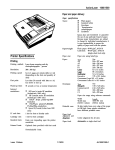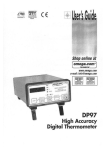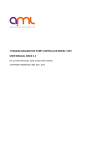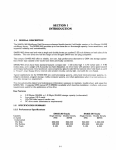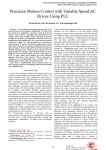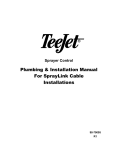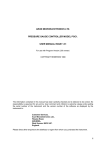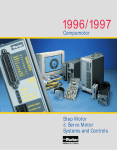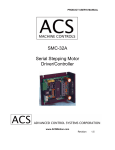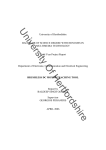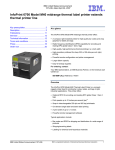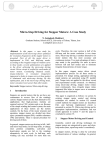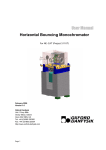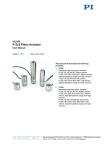Download SMD1 - Arun Microelectronics Limited
Transcript
ARUN MICROELECTRONICS LTD. STEPPER MOTOR DRIVE MODEL SMD1 USER MANUAL ISSUE 1.01 COPYRIGHT RESERVED 1996, 1997 The information contained in this manual has been carefully checked and is believed to be correct. No responsibility is assumed for any errors. User comment and criticism is welcome: please write quoting the serial number of the instrument and the version number of the program to: Customer Services, Arun Microelectronics Ltd., Fitzalan Road, ARUNDEL, West Sussex. BN18 9JP. England. Please direct other enquiries to the distributor or agent from whom you purchased the instrument. CONTENTS INTRODUCTION DESCRIPTION 2:1 Front Panel Indication, Controls and Connectors. 2:2 Rear Panel Connectors 2:3 Internal Controls (Links) INSTALLATION 3:1 Instrument installation. Mounting. Ventilation. Connection to the mains supply and earthing. 3:2 Fusing. 3:3 Wiring of the motors to the vacuum feedthrough. Feedthrough requirements. Wiring accessories. Lead identification and interconnection. Lead Stripping. Screening the wiring. Lead connection to the feedthrough pins. 3:4 Wiring between the vacuum feedthrough and the drive Using AML cables. Using custom-made cables. Checking the motor-to-drive connections Reversal of rotation of motors. OPERATION. 4:1 Manual Control. . 4:2 Control via the User Connector. 4:3 Notes on Acceleration, Resonance and Speed. 4:3 Step Division and Angular Resolution. AML SMD1 Manual Issue 1.01 Copyright 1997 1 2.INTRODUCTION. SMD1 is a self-contained, mains-powered drive for UHV stepping motors up to B23.1. It is intended for low-cost applications in stand-alone or externally-indexed modes and also for multi-axis drives when controlled by a programmable motion controller. It complements the SMD2 and extends the range of applicability of AML drives at both the high and low-ends. Half-step and wave-drive full-step modes are provided. An enhanced version, SMD1M, supports step division. Although intended and equipped with thermal management functions required for use with vacuum motors, it is economical when used with conventional motors. This equipment meets the intent of the EU EMC Directive 89/336/EEC and the Low Voltage Directive 73/23/EEC. Certificates of Conformity are available from AML Customer Services. AML SMD1 Manual Issue 1.01 Copyright 1997 2 2. DESCRIPTION. >T RDY A JOY USR V 1 SMD1 UHV STEPPER MOTOR DRIVE 2:1 FRONT PANEL INDICATION, CONTROLS AND CONNECTORS. The following descriptions cover the basic function of the indicators, connections and controls and are not exhaustive. Further information is contained in the operation section. '1' Mains power indicator. A green LED indicator is provided: it is illuminated when the instrument is connected to the power supply. 'RDY' Ready indicator. A yellow LED indicates that the drive is in a condition where the motor may be driven. When mains power is connected to the SMD1 this indicator illuminates slowly a few seconds after the mains power indicator. 'A' Acceleration control. This potentiometer controls the rate at which the motor accelerates and retards under the control of the internal oscillator. The acceleration rate is controlled by the position of this control, so that zero to full speed takes from a fraction of a second at minimum setting to about a second at maximum. The acceleration time is also dependent on the setting of the speed control. 'V' Speed control. This potentiometer controls the rate at which the motor steps or ministeps under the control of the internal oscillator. The minimum speed is less than 200Hz and the maximum is greater than 5kHz. '>T' Motor over-temperature indicator. A red LED indicates that the motor temperature exceeds 175°C. Motor drive is disabled when this LED is illuminated. An open-circuit or disconnected thermocouple causes an over-temperature indication. This LED flashes at other times: q.v. NOTEMP in the Operation section for details. User Connector. The user connector is a 8 way DIN audio socket. connections and equivalent circuits are: A mating plug is provided in the accessory kit. Pin +5V 47K 470R 470R NOTMP SO SZ 4V7 CMOS, 5V 4V7 0V 0V +5V +5V 47K 470R NCW 47K 470R CMOS, 5V OTHER INPUTS 4V7 4K7 0V CMOS, 5V 4V7 0V +5V OR 0V EQUIVALENT CIRCUITS 1. RDY. Ready, output. High when the drive is ready to operate. AML SMD1 Manual Issue 1.01 Copyright 1997 3 2. SO. Step out. A short positive-going pulse related to the rising edge SI or equivalent to the internal oscillator when NGO (on the joystick connector) is low. 3. SZ. Step zero, output. High when phase A only is energised with current flowing from pin 1 to pin 2 of the motor connector. 4. NOTMP. Not Overtemperature. Low for an overtemperature or open-circuit thermocouple. 5. SI. Step in. Motor steps or ministeps on the rising edge, provided NGO on the joystick connector is low. 6. NCL. Not clockwise limit input. When low this inhibits further stepping in the clockwise direction. 7. NCCL. Not counter- clockwise limit input. When low this inhibits further stepping in the counter-clockwise direction. Shell (Screen). Connected to OV, earth. The use of these signals is described in detail in the operation section. Joystick Connector. The user connector is a 3 way DIN audio socket. Mating male connectors are readily available and 180° 5 pin types are also suitable. Connecting the AML model SMDJ joystick to this connector allows direction and step control to be performed on the joystick. Direction signals applied to the User connector override the joystick NCW signal. 3. 0V 1. NCW The 'NGO' signal on this connector may be driven to extend the range of control possibilities of the User Connector. This is described in the operation section 2. NGO Shell (Screen). Connected to OV, earth. JOY 2:2 REAR PANEL CONNECTORS. 100/110V(SMD1L) 230V (SMD1H) 50/60Hz, 50W MOTOR K T/C MODEL SMD1 SER.No. Mains Connector. This is a IEC CEE22 pattern male connector with an integral fuseholder.. A mating mains lead is included in the accessory kit. The M5 stud adjacent to the mains connector must be permanently connected to mains earth. Thermocouple Connector. This is a Type K flat-pin female thermocouple connector with compatible contact materials. The mating free male connector is ‘Labfacility’ type FMTC-K-M, or equivalent. This connector is used on AML MLF12 and other motor leads and is included in AML motor connection kit SMDMCC. Motor Connector This is a 4 way ’Trident’ rectangular female connector. The mating male connector is available from ITT Cannon, Framatome and other manufacturers and suppliers. This connector is used on AML MLF12 and other motor leads and is included in AML motor connection kit SMDMCC. Wiring of motors is described in detail in the installation section. AML SMD1 Manual Issue 1.01 Copyright 1997 4 2:3 INTERNAL CONTROLS (Links). Removing the cover. Disconnect the mains lead before removing the cover. If the mains lead is removed when the motor is not being driven the energy stored in the capacitors is discharged over a few seconds. The persistence of this energy store is indicated by the ‘RDY’ LED on the front panel. For this reason the drive should not be connected to the mains when the cover is not fixed to the chassis. Remove the four screws at the sides near the ventilation slot and lift the cover upwards. The fifth screw in the cover which is situated near the mains connector, must not be removed. LK2 LK1 LINKPARK FUSE Setting the motor phase current. Instruments are shipped with the phase current set to 500mA, for safety. The recommended initial phase current for B23.1 motors is 500mA and for B14.1 and B17.1 motors driving mechanisms it is 1 amp. It is probable that the motor can be run at lower phase currents in most applications and this will decrease the gas load. LK1 0.25A 0.5A 0.75A 1.0A Phase currents are set by fitting a single link to LK1. Fit the link in one of the four locations shown in the diagram at the left, corresponding to the desired current. A link must be fitted or the phase current will be indeterminate. Spare links are stored on "LINKPARK” Setting the drive step mode. SMD1 provides either full step wave drive or half step drive to the motor. SMD1M provides in addition step division by 4,8,16 or 32. Wave drive provides the phase current to only one of the two phases at any one time. All the other drive modes provide currents to both phases and the direction and magnitude of these is varied, according to the substep position. The drive mode is selected by fitting combinations of links to LK2. The used combinations are shown in the table below, where XXX denotes a link. All unused or undefined combinations result in full step mode being used. Modes marked * are only available in SMD1M. LK2 MS0 MS1 MS2 HOLD The function of the hold link is described below. Spare links are stored on "LINKPARK”. DRIVE MODE FULL MS0 MS1 MS2 HALF QUARTER XXX XXX EIGHTH* SIXTEENTH* XXX XXX XXX XXX THIRTY-SECOND* XXX XXX XXX XXX XXX Setting and function of the HOLD link. Instruments are shipped with this link fitted. Most uses will require the link to be fitted. Only if very infrequent AML SMD1 Manual Issue 1.01 Copyright 1997 5 motion and the absolute minimum of outgassing are required should the link be removed. If the HOLD link is fitted then the phase current is reduced 100 milliseconds after each step or ministep by 50%. If a further step is taken within 100 milliseconds, e.g. for steady stepping at greater than 10Hz, the current is not reduced. Reduction of the phase current reduces the holding torque by about half. The 100 millisecond delay is sufficient to achieve sufficient damping with normal loads, before the torque is reduced. The power dissipated in the motor while it is stationary is reduced by 75%. In most cases this will reduce outgassing from the motor significantly. If the link is not fitted then the phase current is removed entirely 100 milliseconds after each step or ministep. There is zero power dissipation in the motor when it is stopped. The torque is then reduced to the motor detent torque, which is about 10% of the holding torque at rated phase current. If any drive mode other than full-step is being used then the motor will relax into an adjacent full step position. The direction of rotation into the adjacent full step position will be indeterminate and so that any mechanism for tracking of position will have a possible additional error of half a step. If zero power is required when the motor is stopped ( i.e. when the hold link is absent ) and a step-division mode and absolute positioning are all required then precautions must be taken to avoid power being removed at a sub-step position. Following two simple rules will achieve this. Step at more than 10Hz. Only stop at a full step position. The SZ signal will help to track full step positions rotating in a consistent direction). This signal is high for every fourth full-step position (when Replacing the cover. Ensure that there are no loose links or foreign material inside the instrument. Replace the cover and screws in the correct locations. Do not use screws longer than those supplied. AML SMD1 Manual Issue 1.01 Copyright 1997 6 3. INSTALLATION 3:1 INSTRUMENT INSTALLATION. Mounting. The instrument is intended to be free-standing on its feet. Ventilation. The instrument is ventilated by convection through grilles on the sides top and base of the case. The instrument is tolerant of operation at elevated ambient temperatures up to 30° Celsius, although long-term reliability will be enhanced by operation at the lowest possible temperature. Connection to the mains supply and earthing. The nominal line voltage for which the instrument is set is determined by the model number SMD1L for 100/110V or SMD1H for 230V. The model number is printed on the rear panel. It is not possible to modify the instrument to alter the line voltage. The mains is connected via an IEC CEE22 pattern connector. THE INSTRUMENT MUST ALSO BE CONNECTED TO EARTH BY THE STUD PROVIDED. FAILURE TO PROVIDE THIS CONNECTION MAY RESULT IN A SHOCK HAZARD FOR THE OPERATOR IF EXTERNAL SOURCES OF HIGH VOLTAGES ARE INADVERTENTLY CONNECTED TO THE OTHER LEADS WHEN THE MAINS LEAD IS DISCONNECTED. SUCH MIS-CONNECTIONS ARE COMMON IN VACUUM SYSTEMS. 3:2 FUSING. The rating of the mains fuse is printed on the cover next to the mains connector. It must be replaced with a 20mm x 5mm anti-surge fuse of the same type and rating. Such fuses are marked with a "T" next to the current rating: ceramic fuses are generally unsuitable, even if so marked. The fuse is mounted on the mains connector, inside the case. It is necessary to disconnect the mains supply before removing the cover to inspect or replace the fuse. AML SMD1 Manual Issue 1.01 Copyright 1997 7 3:3 WIRING OF THE MOTORS TO THE VACUUM FEEDTHROUGH. Feedthrough requirements. Each motor requires six vacuum feedthrough pins. Any instrumentation feedthrough should be suitable. All AML motors are provided with a K-type Thermocouple (Chromel/Alumel) embedded between adjacent windings, which must be used for over-temperature protection. It is not necessary to use a thermocouple vacuum feedthrough, as the error introduced by incompatible feedthrough material is not significant. Wiring accessories. AML supply a kit, MLF12, consisting of a 12-way feedthrough, bakeable external lead and internal connectors. The kit is suitable for one or two motors and two SMD1s. Motors can be supplied ready-wired to an in-vacuum connector, MLF12VCF, which simply plugs onto the inside of the feedthrough. Where two motors share the same feedthrough or on multi-axis mechanisms it is convenient to wire each motor to an AML VTB6 vacuumcompatible terminal block and have a permanent wiring installation between the terminal block and the feedthrough. Lead identification and interconnection. Current AML motors have self-coloured polyimide covered leads without marking. The thermocouple wires are much thinner than the power wires. The Alumel wire (conventionally sleeved in blue) may be identified with a magnet, since it is weakly magnetic. B-Series Motors e.g. B23.1 and B14.1 have windings optimised for use with AML drives and only require connecting to the feedthrough. The two phase windings are identical and arbitrarily designated FA and FB. Identify the separate phases with an ohmmeter. Lead stripping. The motor leads are supplied pre-stripped at their extremities. To strip cut leads use a high-speed rotary stripper or cut a ring round the insulation with a scalpel, taking care not to mark the wire. The insulation is not bonded to the wire and the cut portion can be withdrawn over the end of the wire. Do not attempt to use thermal strippers on polyimide insulation. Screening the wiring. AML SMD1 Manual Issue 1.01 Copyright 1997 8 There are rectangular waveforms of about 70 volts and currents of 1 ampere amplitude with a frequency of 20 kHz present on these wires. If the leads are required to be screened then the screen should be connected to ground. An OFHC copper or stainless steel braid is normally adequate for this inside the chamber. The thermocouple wires should be twisted together to minimise the space between them. Lead connection to the feedthrough pins. Connect the motor leads to the pins by crimp or barrel connectors. MLF12 includes connectors. The motor leads are pre-stripped and should be doubled for insertion into the bore. Thread the wires through a new copper gasket. Do not bend or stress the feedthrough pins as this may cause a leak. To match the wiring of the bakeable leads in the MLF12 kit the connections to the feedthrough must be as follow, where ÞA and ÞÞ are the two phase windings: Feedthrough Pin 1 2 3 4 5 6 Motor 1 FA FB FA FB P N Feedthrough Pin 7 8 9 10 11 12 Motor 2 FA FB FA FB P N After wiring the motor to the feedthrough check the phase and thermocouple resistances with an ohmmeter for correct connection and for unwanted shorts. AML SMD1 Manual Issue 1.01 Copyright 1997 9 3:4 WIRING BETWEEN THE VACUUM FEEDTHROUGH AND THE DRIVE. Using AML cables. Users of the MLF12 kit need only to connect the bakeable connector to the air side of the feedthrough and the other connectors to the SMD1. MLF12 cables are screened. The screen is brought out to a flying lead which must be connected to the SMD1 earth stud. Using custom-made cables. The thermocouples should be connected to the instrument with K-type extension cable using the connector in the accessory kit. Thermocouple extension cable is readily available, inexpensive and normally suitable for use in bakeout zones and should be used wherever possible. Take care to ensure consistent polarity throughout and connect the blue Alumel wire to the connector pin marked "-". Signal voltages from thermocouples are very small so some precautions against induced interference are desirable. Insulated thermocouple wires or extension cables should be twisted together to avoid magnetic induction and routed away from power cables. K T/C _ + Since the current and voltage on the drive are small the phase wiring can be of relatively 2 small cross-section, and 16/0.2mm ( 0.5mm or AWG20 ) wire is recommended. Twisting the pairs of wires for each phase together throughout their length will reduce radiated interference. An overall screen is recommended. Pin connections on the 'Trident' motor connector is shown related to the two arbitrarily-designated windings: MOTOR 1. PHASE A 2. PHASE A 3. PHASE B 4. PHASE B Checking the motor-to-drive connections. It is essential that the drive, wiring and motor combination work properly before closing the vacuum system. The simplest check is to measure the resistances between pins on the motor and thermocouple connectors before they are connected to the SMD1 drive. Between pins 1 and 2 of the motor connector you should measure approximately the phase resistance of the motor. If the cables are several metres long the measurement may be increased by a few ohms. A similar resistance should be measured between pins 3 and 4. Between pins 1 and 3 there should be an open circuit. Check that there is an open-circuit between both phases and the vacuum chamber ground. The resistance between the pins of the thermocouple should be a few tens of ohms and there should be an open circuit to the motor connector. Reconnect the drive and exercise the motor using the joystick or 'Step' and 'Direction' switches. Reversal of rotation of motors. Since the phases are not identified there is a 50% probability that the direction of rotation will be reversed from the desired or conventional sense. To reverse the direction exchange the connections to only one of the phases. AML SMD1 Manual Issue 1.01 Copyright 1997 10 4. OPERATION. Ensure that the motor and thermocouple connectors are properly connected before inserting the mains connector or switching on the supply. 4:1 MANUAL CONTROL. An AML joystick, SMDJ, may be connected to the front panel ‘JOY’ connector. This has a toggle switch for control of direction and a push-button switch for stepping. A single brief push on the button will cause the motor to execute a single step or ministep, as defined by the internal links. If the button is held down then the motor will accelerate, according to the setting of the ‘A’ and ‘V’ controls on the front panel. When the button is released the motor will retard to a stop. The direction of rotation can only be changed while the motor is stationary. If the toggle switch is moved when the motor is moving this will be ignored until the motor has stopped. The NGO signal is low when the button is pressed. Some practice may be necessary to achieve single stepping using the joystick. Very brief presses, no faster than two or three per second should be used. Erratic stepping may be caused by inappropriate settings of phase current, acceleration, step division or maximum speed for the load inertia or friction. Refer to section 4:3, below for general advice on these points. 4:2 CONTROL VIA THE USER CONNECTOR. The inputs on the User Connector may be driven by 5V CMOS or LSTTL logic. A 47k internal pullup resistor is provided, so that unused inputs are in a defined state. The use of contact closures to drive inputs is not recommended, other than for limit switches. The inputs and outputs are protected against mis-connection to voltages in the range ±15v DC. SI. The motor will step or ministep on a positive transition of the Step Input (SI), provided the NGO signal on the ‘JOY’ connector is high (when the button is not being pressed of if the joystick is not connected). The SI signal must remain high for 100ms, minimum and have a maximum frequency of 5kHz. The maximum frequency and acceleration for which the motor will step reliably is defined by the motor characteristics, phase current and load conditions. NCW. When this input signal is low the motor will step in a clockwise direction, when it is high the motor will step in a counter-clockwise direction. This input overrides the direction commanded on the ‘JOY’ connector. The state of this input must only be changed when the step rate is such that the motor is able to respond to a reversal of rotation, otherwise synchronism will be lost. SO. This signal follows the SI input. A 100ms positive-going pulse is produced after every positive transition of the SI input. When the joystick or equivalent is used (i.e. when NGO on the ‘JOY’ connector is low) then SO follows the internal oscillator. This signal enables the controlling system to track motion, whether this is controlled by the SI input or by the joystick.. SZ. This signal is high when only phase A is energised in the positive direction. This occurs on every fourth step for full-step control, every eighth step for half-stepping etc., in a consistent direction. This signal is useful for tracking full-step positions, which are the only ones where the motor power can be removed without altering the rotor position. Step zero condition is established after the mains supply is connected. If position is to be preserved while the supply is disconnected it is necessary to leave the motor at a step-zero position. RDY. This output signal is high when the drive is ready to operate. When the mains supply is connected It remains low for 3 seconds then pulses at 100Hz for 1.2 seconds. It is low when there is a fault condition. Fault conditions include a short- circuit across or between motor phases or from a phase to ground. NOTMP. The ‘>T’ LED is driven by this signal and is illuminated when NOTMP is low. NOTMP indicates either that the motor is too hot or that some other fault or a microprocessor reset condition has occurred. NOTMP goes low when the thermocouple indicates that the motor is at >175°C or if the thermocouple is opencircuit or disconnected. If this occurs then step commands are accepted for 1.3 seconds, to allow the motor to be retarded and stopped without loss of a record of its position, (at a full-step or step- zero position). Phase current is then removed and the RDY output set low until the motor cools by 10 to 15° or until the thermocouple is reconnected. The state of the phase currents (the step and substep number) is preserved during an overtemperature condition. If the NGO signal is low when an overtemperature condition is cleared the NOTMP output pulses at 0.5Hz and motor power remains off until NGO goes high. NOTMP will pulse at 1Hz for 3 seconds following connection of the mains. If NGO is low at the end of the 3 AML SMD1 Manual Issue 1.01 Copyright 1997 11 second period NOTMP will continue to pulse until it goes high. NOTMP pulses at 2Hz for 3 seconds after an external reset and at 4Hz for 3 seconds after an internal reset of the SMD1 microprocessor. NOTMP pulses at 10Hz if excessive current is drawn from the motor connector, e.g. by a short-circuit output or inappropriate motor. This fault indication can only be cleared by disconnecting the mains supply from the SMD1. NCL and NCCL. These inputs are the clockwise and counter-clockwise limits. If the clockwise limit input goes low when the motor is stepping in the clockwise direction stepping action in that direction is inhibited and only steps in the opposite direction have an effect. The counter-clockwise limit operates in the same way. These signals may be used to force a reset of the SMD1 processor. To do this both limit inputs must be low and eight pulses applied to SI. 4:3 NOTES ON ACCELERATION, RESONANCE AND SPEED. The following notes are an introduction to a complex subject. References to comprehensive sources are given at the end of this section. Stepping motors are moved from one detent position to another by the magneto-motive force produced by the phase current. The rotor and load inertia has to be accelerated and retarded and frictional forces opposed. No useful work is done after the new position is reached. When the motor is rotating at significant speed it generates a voltage which opposes the drive. The self and mutual inductance of the windings oppose changes of phase current. Energy has to be supplied and removed from the motor by the drive for each step. After a step has been taken the rotor tends to oscillate about the new rest position. At stepping rates of more than a few tens of Hz the rotor does not stop between steps and its stored kinetic energy becomes significant. These characteristics give rise to resonances, and limits to acceleration and speed. All stepping motors exhibit resonances at low frequencies, usually below 100Hz and again at 500Hz to kHz, when unloaded. These frequencies cannot be stated with any precision, as they are affected by the load and drive conditions. Load inertia reduces the resonant frequency. Increasing the phase current usually increases the lower resonant frequency. Operation at or near the resonant frequencies can cause erratic stepping. This can be alleviated at low frequencies by ministepping or by starting the motor at a frequency above resonance. Operation at the higher resonant frequency is best avoided. A small friction load will often damp resonances. Acceleration or retardation through the resonance region does not usually result in any problem. The maximum acceleration which can be sustained is related to the energy interchange so larger inertia loads have to be accelerated more slowly. If the maximum speed requirement is consistent with the use of ministepping then the greatest step division available or possible should be used. Higher phase current settings will allow greater accelerations. At speeds above 1Khz the inductance of the windings becomes a limiting factor, since there is insufficient time during each step for the phase current to reach the set current in full-step mode. It is principally this effect which causes the torque of the motor to fall with increasing frequency. In B23.1 motors the motional voltage is also significant. For this reason it may be desirable to reduce the acceleration to achieve the highest possible speeds. For more information refer to one of the following inexpensive textbooks: ‘Stepping Motors: A guide to modern theory and practice” by PP Acarnley, published by Peter Peregrinus, ISBN 0 86341 027 8 or ‘Stepping Motors and their Microprocessor Controls’ by Takashi Kenjo published by the Clarendon Press, ISBN 0 19 859339 2 AML SMD1 Manual Issue 1.01 Copyright 1997 12 4:3 STEP DIVISION AND ANGULAR RESOLUTION. The basic step angle of an AML hybrid stepper motor is 1.8°. At the full step positions the teeth on half the rotor poles are in alignment with rotor teeth. On adjacent steps the teeth are aligned on the other set of poles. These positions are also a condition of minimum reluctance for the magnetic circuit, so that the rotor will relax to a full step position in the absence of phase current. The torque required to move the rotor from one step position to the next is the detent torque when the phase current is zero or the pullout torque when there is phase current. In full step mode the phase current flows in different windings on alternate steps. If the two phase windings, A and B, are visualised as being at right angles then the resultant flux can be considered to be rotating 90° on each step thus: A+ A+ B+ B A _ _ CLOCKWISE ROTATION A+ A+ B _ B+ _ A COUNTER-CLOCKWISE ROTATION If both phases are energised with equal currents then the flux vector will swing to a 45° position and the rotor will step halfway between detent positions. Part of a half-stepping sequence is shown below: A+ A+ R B+ B+ B+ A CLOCKWISE ROTATION HALF-STEPPING _ R A _ The rotor may be moved to an intermediate position by scaling the currents in phases A and B to swing the angle of the resultant. The physical movement of the rotor is one fiftieth that of the notional flux vector. By this means greater subdivisions of the step angle can be achieved. SMD1 supports full, quarter and half step modes and SMD1M supports eighth, sixteenth and thirty-second step modes, in addition. To aid tracking the SZ signal is high when only phase A is energised in the positive + direction, i.e. A in the diagrams. The principal advantages of ministepping are that the transient impulse given to the rotor is much reduced and the damping factor is increased. These lead to much smoother low-speed rotation and greater freedom from resonance. Angular resolution can be improved somewhat by step-division, but there are limits to the degree and the circumstances when this is appropriate. The differential torque between ministeps is progressively reduced with increasing number of steps; when this becomes comparable to the static friction in the system no further improvement can be obtained. The positional error due to the manufacturing tolerances are fixed at about 4% of a full step. Generally, it is not possible to obtain an improvement of resolution of an unloaded motor better than can be achieved by quarter or eighth stepping, unless some feedback device is available to close the control loop. In UHV applications it is always important to run the motor at minimum power, to reduce outgassing. With SMD1 the ‘HOLD’ link must be fitted if the motor is to be stopped at sub-step positions. In this case the motor power is reduced by 75% when it is not moving. If the ‘HOLD’ link is not fitted then the power is zero when the motor is not moving, however, the rotor will relax into an adjacent full-step position. For ultimate UHV performance it is usually better to increase angular resolution by using anti-backlash reduction gears and only stop the motor at full-step positions than to use step division. END. AML SMD1 Manual Issue 1.01 Copyright 1997 13














